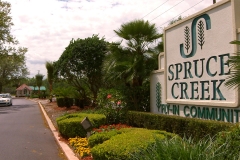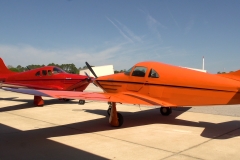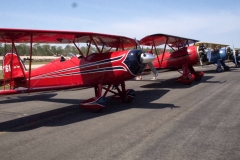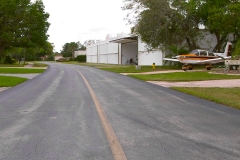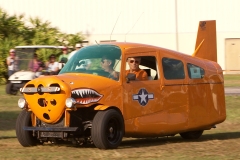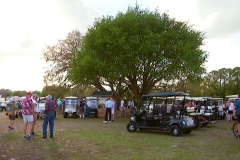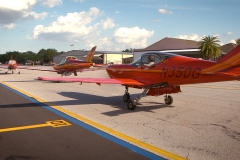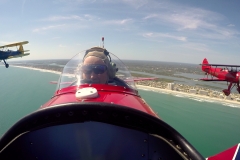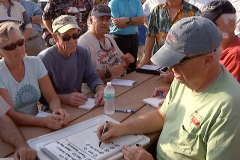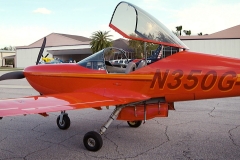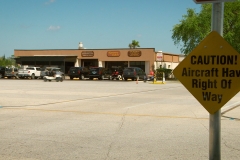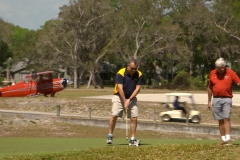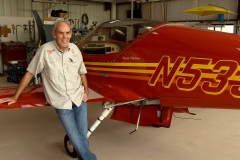I heard so much about our next stop on the Florida Foray I was secretly hoping I wouldn’t be disappointed. The Spruce Creek Fly-In community has been called the world’s most famous residential airpark and is currently the world’s largest. Almost 600 aircraft are based there alone! There are 1,500 homes and condos with 450 taxiway lots. They house almost 4,500 people. Yes, it’s big!
Spruce Creek was originally an outlying airfield for the U.S. Navy during World War II. It had four paved 4,000-foot runways and was abandoned by the Navy in 1946. Today, only one of those runways has survived with portions of the other three used as taxiways and ramp space. The current 5/23 runway is 176 feet wide.
Spruce Creek has a unique layout with an interior taxiway system and an external road system. Very seldom do vehicles and aircraft share the same pavement. I got a kick out of seeing the signs “Caution Aircraft have the right of way” (as it should be). Speaking of signs, the one near the main gate was cool too: “Caution children and adults at play.” By the way, Spruce Creek also features a very nice 18-hole golf course and country club. There is a clever sign located there also that reads: “Check for low flying aircraft before teeing off”!
Our day started with a briefing by our host, retired U.S. Air Force Col. Keith Phillips. He would be our organizer for the next three days. We met at his “very social” hangar, which is used by different groups and entities at Spruce Creek. The Daytona Beach EAA chapter, 288, meets at this location but still maintains close ties to the Daytona area. Chapter 288 is the largest EAA chapter. Our time was scheduled to a T and we shot out of the colonel’s briefing going in two different directions. Videographer Scott Giese and Jim Busha would go in one direction to shoot interviews with residents that Keith had lined up and I headed out with residents Sal, Mike, and Chad to shoot general footage of hangar interiors and aircraft. Way too much fun!
We headed to an older section of the community, built in the ’70s. This area reminded me of an old TV show or movie set. There were perfect homes with white fences and wide streets that were actually taxiways. I was waiting for Wally, Beaver, and Eddie Haskell to walk up to me at any minute. I looked up and along came a Grumman Widgeon taxing by. The pilot waved, shuts both engines off, and rolled to a parking spot in front of his connecting hangar and home. Pretty cool, Wally!
Each and every hangar-home we visited was special and exciting. Every kind of aircraft could be found. Most were homebuilt airplanes with their owners and builders standing by to show their wares. That round engine RV-8 featured in the October 2016 issue of Sport Aviation was there. Vintage aircraft like two of the only three surviving Johnson Rocket 185s are located here. A hangar filled with WWII jeeps, military trucks, a half track and a P-51 could be found. I could go on for hours about this place; it was so cool. You’ll just have to look out for EAA’s video and upcoming article about the trip in Sport Aviation to hear more.
By the way, there really is a creek at Spruce Creek. We visited the idyllic small park and pier area. The gated community features a bar and restaurant, barber shop, several relators, an airport FBO, an avionics shop as well as other aviation and non-aviation related businesses.
Our team had a chance to take part in one of the weekly lunch sorties on a fly-out to nearby Flagler County airport. A great lunch with some excellent hangar talk took place. The crew split up after lunch with part of the team going to capture a story at nearby Emery-Riddle Aeronautical University. On the flight back to Spruce, I got a great shot of a four-ship formation with Dayton Beach in the background.
One of the activities taking place that week was the annual gathering by the Swearingen SX-300 owners group. I have been a big fan of the SX-300 since designer Ed Swearingen debuted it in the early ’80s. I saw it at Oshkosh back in the day. I think the SX-300 is the only airplane that looks as sharp on the ground as it does in the air. Its landing gear is extended in a somewhat foreword swept manner giving it a racy, swift look. The SX-300 is an all-aluminum 300-hp hot rod with side by side seating. It was offered as a kit but was found to be somewhat difficult to be built. By 1989, 80 kits had been sold but only 48 sets of landing gear. Today, approximately 35 aircraft are flying and a few more “new” aircraft take to the skies each year.
The annual gathering isn’t just for the flying and hangar talk. The group, working together continue to make major and minor improvements to the current flying aircraft and for the builders who are still putting their 300s together. The group worked with Hartzell Propeller to develop a prop specifically for the 300. One builder designed, built new molds and finally laid up a new four-piece carbon fiber cowl with smaller air inlets, a sleeker look and stronger structure. The cowl has a finished weight that is 8 pounds lighter than the original. Several other new upgrades for all the SX-300 group member’s aircraft continue to be develop.
Our guide, Chad, happens to be building a SX-300 of his own. We had a chance to stop at his garage based shop and talk about his experiences building up this hot rod of the air. He ran us through a list of changes he had to do from the previous builder’s attempts and showed several of the upgrades he will incorporate into his 300. I always give a lot of credit to a homebuilder or major restorer. The talent, patience, and perseverance it takes to finish a project really show through.
Friday night is social night at Spruce Creek. All the golf carts gather, many carrying food and drink with them near the end of a runway in a spot known as “the big tree.” Here the real diversity of the community members could be seen. As the crowd relaxed and enjoyed the soon to set sun, briefings for fly-bys were taking place. One of our guides, Dennis, loaned us his hand-held radio, headsets, and other goodies so we could record the radio calls of the formation fly-bys. Their professionalism could not only be seen but also heard.
The crowd as well as our EAA team enjoyed the formation fly-bys. A wide variety of aircraft flew that evening. A DC-3 did a few passes and the evening ended with a P-51 Mustang ripping up the evening sky.
We packed our gear, said our goodbyes, and were off to our next city and destination. America’s Seaplane City — Tavares, Florida — for the Seaplane-a-Palooza splash-in to be held early the next morning. I polished up my Seaplane Pilot Association membership card and got my flying sandals ready. It’s time to get our feet wet!
This is the second in a series of three posts. Read part 1 | Read part 3


